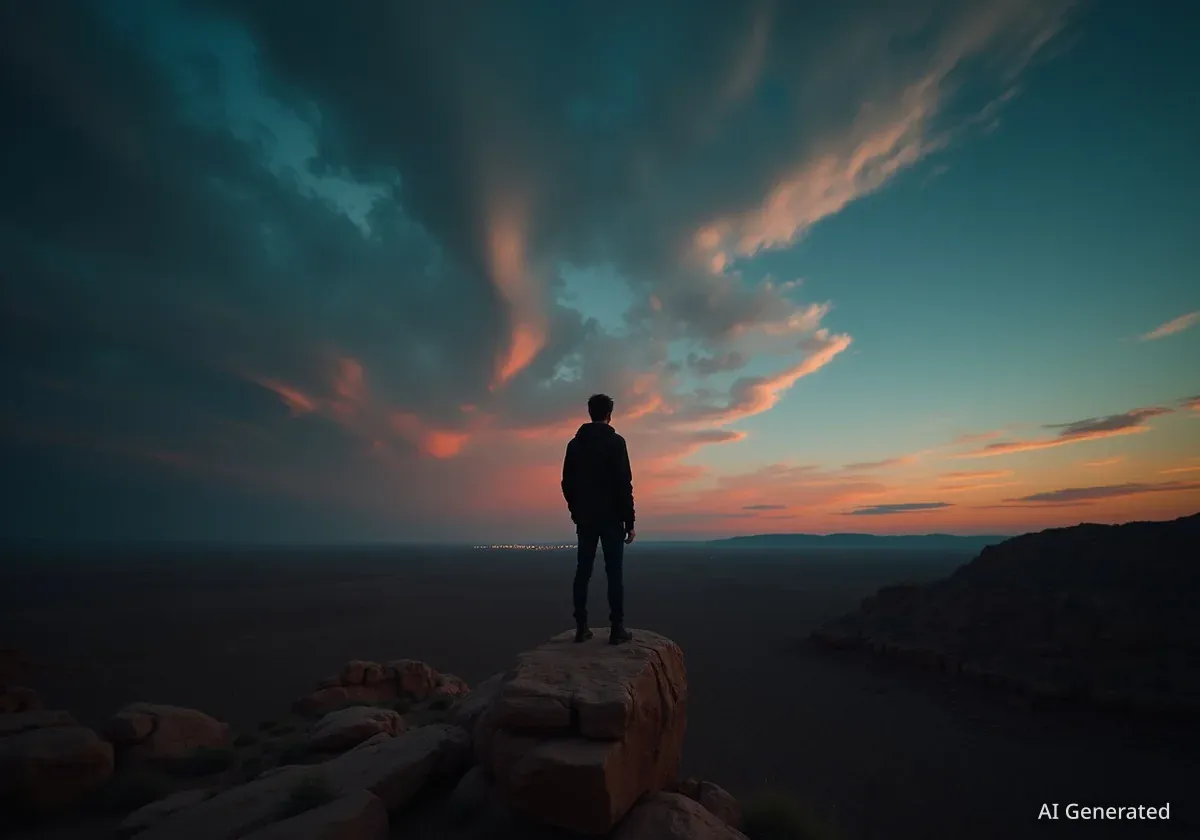Science-fiction author Daniel H. Wilson, a member of the Cherokee Nation, has released a new novel titled “Hole in the Sky.” The book merges traditional Cherokee stories, including legends of “Sky People” from the Pleiades star cluster, with the current global interest in Unidentified Anomalous Phenomena (UAPs), also known as UFOs.
Key Takeaways
- Daniel H. Wilson's new novel, “Hole in the Sky,” combines Cherokee mythology with modern UAP discussions.
- The author draws a parallel between typical alien invasion narratives and the historical colonization of Indigenous peoples in the Americas.
- Wilson's background includes a Ph.D. in robotics and writing threat assessments for the U.S. Air Force, experiences which informed the novel.
- The story is currently being adapted for Netflix, with director Sterlin Harjo (“Reservation Dogs”) attached to the project.
A New Perspective on Alien Contact
In his latest work, Wilson offers a different take on the classic first-contact story. Many science-fiction tales of alien invasion involve extraterrestrials arriving to exploit Earth's resources, displace its population, and dismantle its cultures. Wilson suggests these narratives often reflect a historical reality experienced by Indigenous peoples.
“In an alien invasion, the aliens show up, and they usually want to extract our resources, take our land, our water, destroy our culture, enslave us,” Wilson stated in an interview on the Fiction Science podcast. He explained that this common trope can be seen as a projection of anxieties rooted in the history of colonization.
Historical Context in Science Fiction
The theme of colonization has long been a subtext in science fiction. H.G. Wells' The War of the Worlds (1898) is often interpreted as a commentary on the actions of the British Empire. Wilson's work makes this connection explicit, framing the narrative from an Indigenous viewpoint and re-examining who the “aliens” truly are in such scenarios.
By starting from this premise, “Hole in the Sky” reframes the alien encounter, grounding it in a perspective that is often overlooked in mainstream science fiction. The novel explores what first contact might look like for communities that have already survived a world-altering arrival of outsiders.
Weaving Mythology with Modern Science
The narrative of “Hole in the Sky” is deeply rooted in Cherokee culture and mythology. Wilson incorporates traditional stories and figures, connecting them to the central plot involving extraterrestrial contact. One such figure is Tsul ‘Kalu’, also known as Judaculla, a giant-like being from tribal lore.
In the novel, this character represents a form of Indigenous technology and wisdom. “If you think about the human embodiment of Indigenous technology, it would be the Judaculla,” Wilson said, explaining that this being embodies the advanced knowledge required to maintain ecological balance, a stark contrast to modern resource exploitation.
Spiro Mounds
The novel also centers on Spiro Mounds, a significant archaeological site in eastern Oklahoma. This complex of earthworks was a major ceremonial and political center for Caddoan peoples centuries ago, making it a powerful and culturally rich setting for the story's events.
Alongside these cultural elements, Wilson integrates contemporary scientific concepts and events. The story references the U.S. military's renewed focus on UAPs, a topic that has moved from fringe speculation to a matter of national defense discussion.
The novel also draws on real-world space science, including:
- NASA's Voyager Probes: The spacecraft have traveled beyond the heliopause, the boundary where the sun's influence gives way to interstellar space. Wilson uses this as a narrative device, suggesting it is a place where something ancient could be awakened.
- Interstellar Objects: Recent discoveries of objects like ‘Oumuamua passing through our solar system have fueled scientific and public curiosity. Wilson uses these observations as a basis for how the aliens in his story might arrive.
From Robotics to Fictional Threats
Daniel H. Wilson's background uniquely positions him to write at the intersection of technology, defense, and fiction. Before becoming a full-time novelist, he earned a Ph.D. in robotics from Carnegie Mellon University. This expertise is evident in his earlier best-selling books, such as Robopocalypse and How to Survive a Robot Uprising.
“This is what I do with my writing. I mean, I was a scientist.”
In addition to his academic work, Wilson has consulted for the U.S. military, writing threat assessments for the Air Force. In this role, science-fiction authors are paired with analysts to create fictional scenarios demonstrating the potential capabilities of emerging technologies.
Wilson described his surprise at how seriously military officials take the issue of UAPs. “Nobody’s saying they’re aliens, but we don’t know what they are, and we’re intensely interested in learning more because it is a major defense issue for our country,” he recalled. This experience directly inspired the plot of “Hole in the Sky,” making him consider the real-world possibility of a first-contact scenario.
Bringing the Story to the Screen
The novel has already generated significant interest for an adaptation. Wilson confirmed that he is currently adapting “Hole in the Sky” for Netflix. This development suggests the story's themes are resonating with a wider audience.
Attached to direct the project is Sterlin Harjo, a prominent Native American director and writer known for his work on the critically acclaimed series Reservation Dogs. Wilson expressed his excitement about the collaboration, praising Harjo as an “incredible Native director and writer.”
While film adaptations can be a lengthy process—Wilson noted his novel Robopocalypse has been in development for 15 years—the attachment of a high-profile director like Harjo indicates strong momentum for the project. The adaptation provides an opportunity to bring a story rich in Indigenous culture and modern science fiction to a global audience.




